

Compact Muon Solenoid
LHC, CERN
| CMS-SMP-19-008 ; CERN-EP-2020-143 | ||
| Observation of electroweak production of W$\gamma$ with two jets in proton-proton collisions at $\sqrt{s} = $ 13 TeV | ||
| CMS Collaboration | ||
| 24 August 2020 | ||
| Phys. Lett. B 811 (2020) 135988 | ||
| Abstract: A first observation is presented for the electroweak production of a W boson, a photon, and two jets in proton-proton collisions. The W boson decays are selected by requiring one identified electron or muon and an imbalance in transverse momentum. The two jets are required to have a high dijet mass and a large separation in pseudorapidity. The measurement is based on data collected with the CMS detector at a center-of-mass energy of 13 TeV, corresponding to an integrated luminosity of 35.9 fb$^{-1}$. The observed (expected) significance for this process is 4.9 (4.6) standard deviations. After combining with previously reported CMS results at 8 TeV, the observed (expected) significance is 5.3 (4.8) standard deviations. The cross section for the electroweak W$\gamma$jj production in a restricted fiducial region is measured as 20.4 $\pm$ 4.5 fb and the total cross section for W$\gamma$ production in association with 2 jets in the same fiducial region is 108 $\pm$ 16 fb. All results are in good agreement with recent theoretical predictions. Constraints are placed on anomalous quartic gauge couplings in terms of dimension-8 effective field theory operators. | ||
| Links: e-print arXiv:2008.10521 [hep-ex] (PDF) ; CDS record ; inSPIRE record ; HepData record ; CADI line (restricted) ; | ||
| Figures | |

png pdf |
Figure 1:
Representative diagrams for $\ell\nu\gamma$jj production at the LHC for EW production (left), EW production through triple (middle left) and quartic (middle right) gauge boson couplings, and QCD-induced processes (right). |

png pdf |
Figure 1-a:
Representative diagram for $\ell\nu\gamma$jj EW production at the LHC. |
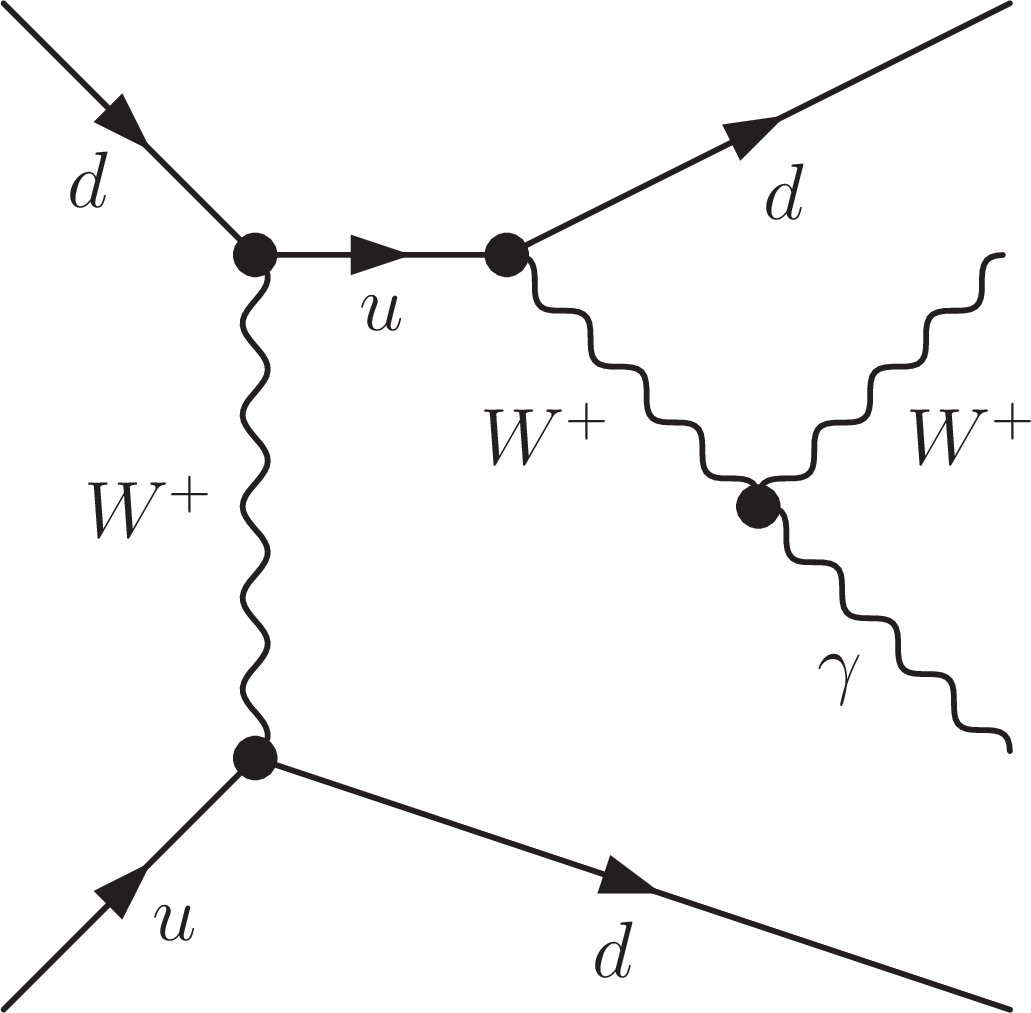
png pdf |
Figure 1-b:
Representative diagram for $\ell\nu\gamma$jj EW production through triple gauge boson couplings at the LHC. |

png pdf |
Figure 1-c:
Representative diagram for $\ell\nu\gamma$jj EW production through quartic gauge boson couplings at the LHC. |

png pdf |
Figure 1-d:
Representative diagram for $\ell\nu\gamma$jj QCD-induced processes at the LHC. |

png pdf |
Figure 2:
The photon ${p_{\mathrm {T}}}$ distribution in the muon barrel control region for data and background estimations. The misID backgrounds are derived from data, whereas the remaining backgrounds are estimated from simulation. All events with photon $ {p_{\mathrm {T}}} > $ 195 GeV are included in the last bin. The hatched bands represent the total and relative statistical uncertainties on the predicted yields. The bottom graph shows the data divided by the prediction. |
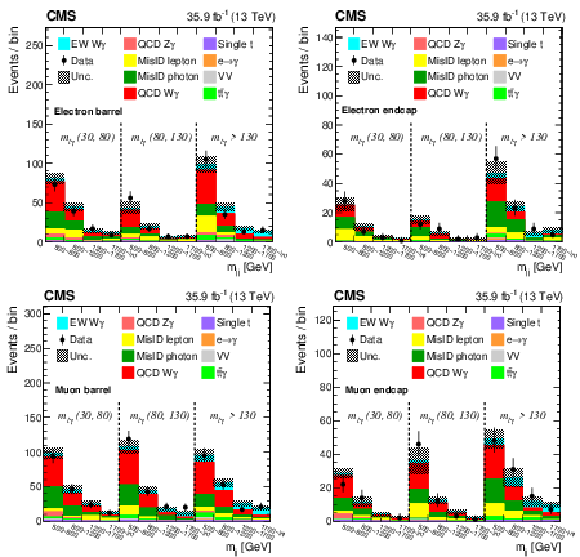
png pdf |
Figure 3:
The 2D distributions used in the fit for the signal strength of EW W$\gamma$+2 jets for events in the electron barrel (upper left), electron endcap (upper right), muon barrel (lower left), and muon endcap (lower right). The hatched bands represent the total and relative systematic uncertainties on the predicted yields. The predicted yields are shown with their best-fit normalizations. |

png pdf |
Figure 3-a:
The 2D distributions used in the fit for the signal strength of EW W$\gamma$+2 jets for events in the electron barrel. The hatched bands represent the total and relative systematic uncertainties on the predicted yields. The predicted yields are shown with their best-fit normalizations. |
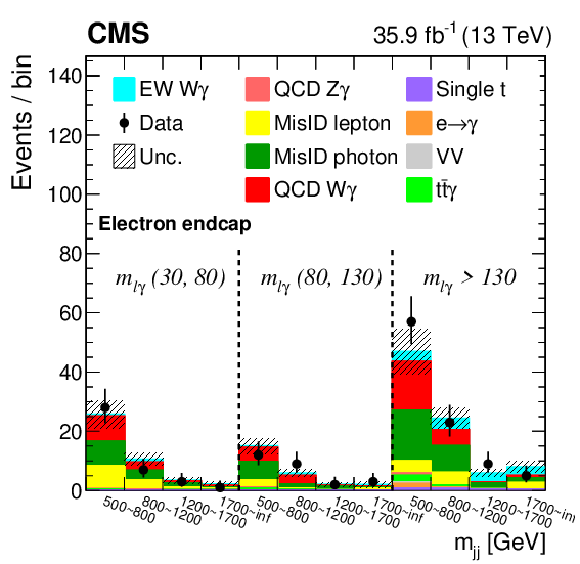
png pdf |
Figure 3-b:
The 2D distributions used in the fit for the signal strength of EW W$\gamma$+2 jets for events in the electron endcap. The hatched bands represent the total and relative systematic uncertainties on the predicted yields. The predicted yields are shown with their best-fit normalizations. |
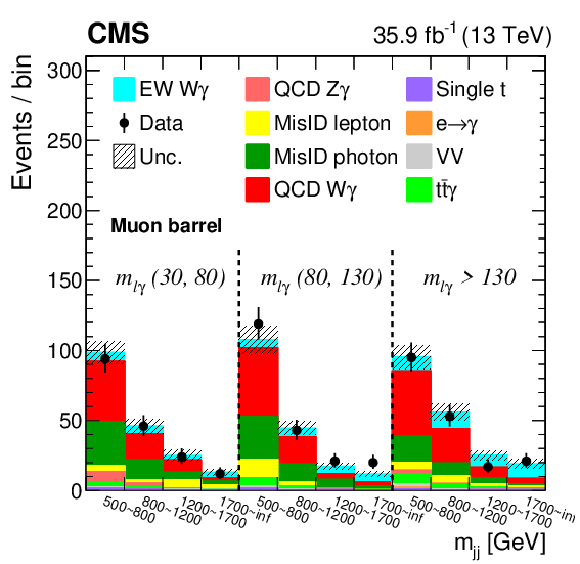
png pdf |
Figure 3-c:
The 2D distributions used in the fit for the signal strength of EW W$\gamma$+2 jets for events in the muon barrel. The hatched bands represent the total and relative systematic uncertainties on the predicted yields. The predicted yields are shown with their best-fit normalizations. |
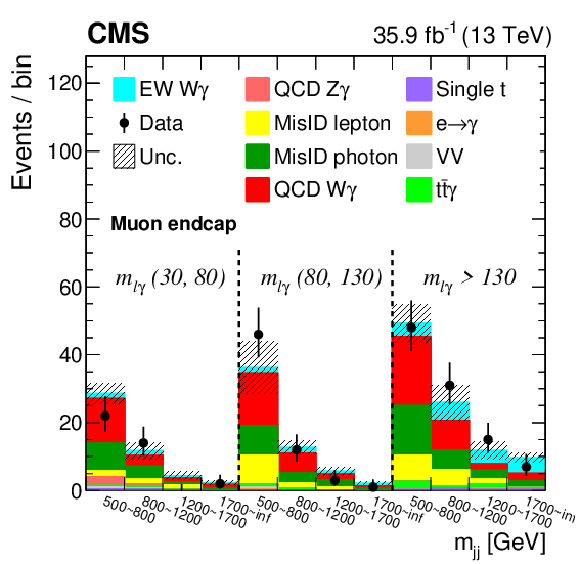
png pdf |
Figure 3-d:
The 2D distributions used in the fit for the signal strength of EW W$\gamma$+2 jets for events in the muon endcap. The hatched bands represent the total and relative systematic uncertainties on the predicted yields. The predicted yields are shown with their best-fit normalizations. |
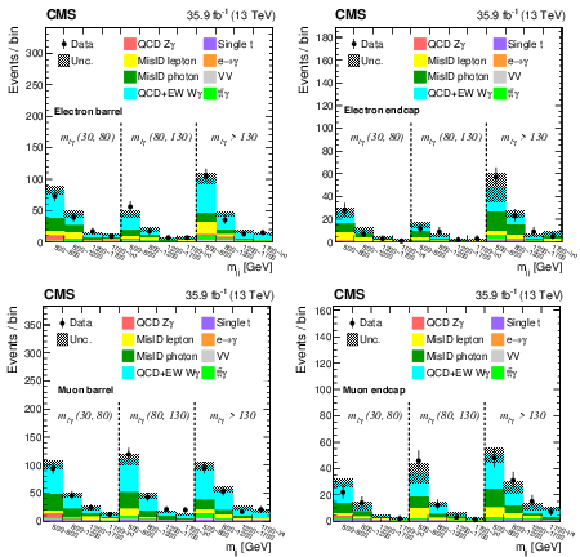
png pdf |
Figure 4:
The 2D distributions used in the fit for the signal strength of EW+QCD W$\gamma$+2 jets in the electron barrel (upper left), electron endcap (upper right), muon barrel (lower left) and muon endcap (lower right). The hatched bands represent the total and relative systematic uncertainties on the predicted yields. The predicted yields are shown with their best-fit normalizations. |

png pdf |
Figure 4-a:
The 2D distributions used in the fit for the signal strength of EW+QCD W$\gamma$+2 jets in the electron barrel. The hatched bands represent the total and relative systematic uncertainties on the predicted yields. The predicted yields are shown with their best-fit normalizations. |

png pdf |
Figure 4-b:
The 2D distributions used in the fit for the signal strength of EW+QCD W$\gamma$+2 jets in the electron endcap. The hatched bands represent the total and relative systematic uncertainties on the predicted yields. The predicted yields are shown with their best-fit normalizations. |

png pdf |
Figure 4-c:
The 2D distributions used in the fit for the signal strength of EW+QCD W$\gamma$+2 jets in the muon barrel. The hatched bands represent the total and relative systematic uncertainties on the predicted yields. The predicted yields are shown with their best-fit normalizations. |
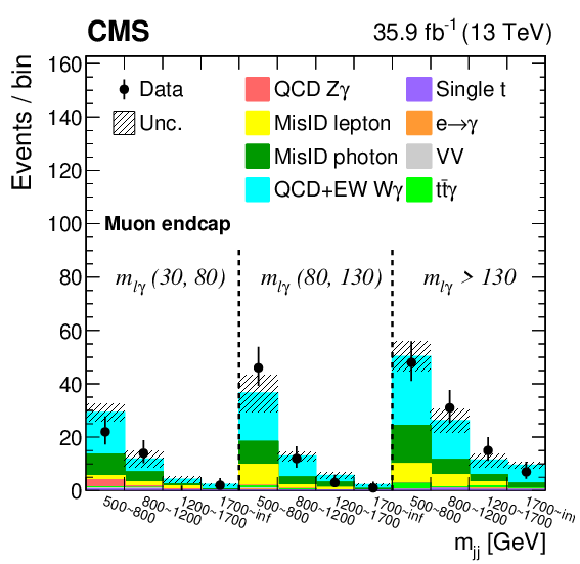
png pdf |
Figure 4-d:
The 2D distributions used in the fit for the signal strength of EW+QCD W$\gamma$+2 jets in the muon endcap. The hatched bands represent the total and relative systematic uncertainties on the predicted yields. The predicted yields are shown with their best-fit normalizations. |

png pdf |
Figure 5:
The ${m_{{\mathrm{W} {}\gamma} {}}}$ distribution of events satisfying the aQGC region selection, which is used to set constraints on the anomalous coupling parameters. The orange line represents a nonzero ${f_{\text {T,0}}/\Lambda ^{4}}$ setting. All events with $ {m_{{\mathrm{W} {}\gamma} {}}} > $ 950 GeV are included in the last bin. The hatched bands represent the total and relative statistical uncertainties in the predicted yields. |

png pdf |
Figure 6:
Observed 95% CL interval on the aQGC parameter ${f_{\text {T,0}}/\Lambda ^{4}}$. |
| Tables | |
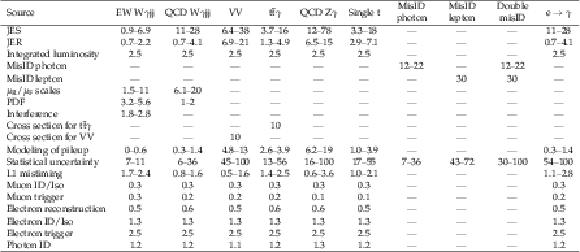
png pdf |
Table 1:
Relative systematic uncertainties in the estimated signal and background yields in units of percent. The ranges reflect the dependence of the specified uncertainty on ${m_{{\text {jj}}}}$ and ${m_{\ell\nu\gamma}}$. |
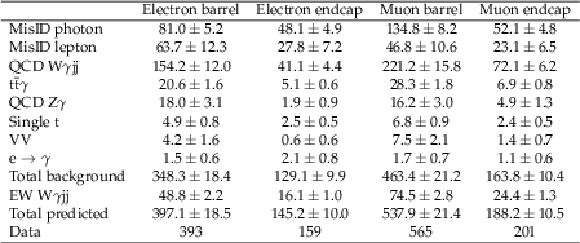
png pdf |
Table 2:
Signal, background, and data yields after the final selection. Statistical and systematic uncertainties (before the fitting) are added in quadrature. |

png pdf |
Table 3:
The exclusion limits at 95% CL on each aQGC coefficient, parameterized using the distribution in ${m_{{\mathrm{W} {}\gamma} {}}}$, and listed along with the unitarity bound. All coupling parameter limits are in ${{\text {TeV}}}^{-4}$, while the ${U_{\text {bound}}}$ values are in TeV. |
| Summary |
| The cross section for the electroweak production of a W boson, a photon, and two jets is measured in proton-proton collisions at a center-of-mass energy of 13 TeV. The data correspond to an integrated luminosity of 35.9 fb$^{-1}$ collected with the CMS detector. Events are selected by requiring one identified lepton (electron or muon), a moderate missing transverse momentum, one photon, and two jets with a large rapidity separation and a large dijet mass. The observed significance is 4.9 standard deviations, where a significance of 4.6 standard deviations is expected based on the standard model. After combination with previously reported CMS results based on 8 TeV data, the observed (expected) signal significance is 5.3 (4.8) standard deviations. This constitutes the first observation of electroweak W$\gamma$jj production in proton-proton collisions. The cross section for the electroweak W$\gamma$jj production in a restricted fiducial region is measured as 20.4 $\pm$ 4.5 fb and the total cross section for W$\gamma$ production in association with 2 jets in the same fiducial region is 108 $\pm$ 16 fb, consistent with standard model predictions. Constraints placed on anomalous quartic gauge couplings in terms of dimension-8 effective field theory operators are competitive with previous results. For the parameters $f_{\mathrm{M},2-5}$ and $f_{\mathrm{M},6-7}$, the constraints are the most stringent to date. |
| References | ||||
| 1 | ATLAS Collaboration | Observation of a new particle in the search for the standard model Higgs boson with the ATLAS detector at the LHC | PLB 716 (2012) 1 | 1207.7214 |
| 2 | CMS Collaboration | Observation of a new boson at a mass of 125 GeV with the CMS experiment at the LHC | PLB 716 (2012) 30 | CMS-HIG-12-028 1207.7235 |
| 3 | CMS Collaboration | Observation of a new boson with mass near 125 GeV in pp collisions at $ \sqrt{s}= $ 7 and 8 TeV | JHEP 06 (2013) 081 | CMS-HIG-12-036 1303.4571 |
| 4 | CMS Collaboration | Observation of electroweak production of same-sign W boson pairs in the two jet and two same-sign lepton final state in proton-proton collisions at $ \sqrt{s}=$ 13 TeV | PRL 120 (2018) 081801 | CMS-SMP-17-004 1709.05822 |
| 5 | ATLAS Collaboration | Observation of electroweak production of a same-sign W boson pair in association with two jets in pp collisions at $ \sqrt{s}=$ 13 TeV with the ATLAS detector | PRL 123 (2019) 161801 | 1906.03203 |
| 6 | CMS Collaboration | Measurements of production cross sections of WZ and same-sign WW boson pairs in association with two jets in proton-proton collisions at $ \sqrt{s}=$ 13 TeV | Submitted to PLB | CMS-SMP-19-012 2005.01173 |
| 7 | ATLAS Collaboration | Studies of W$\gamma$ production in association with a high-mass dijet system in pp collisions at $ \sqrt{s}=$ 8 TeV with the ATLAS detector | JHEP 07 (2017) 107 | 1705.01966 |
| 8 | CMS Collaboration | Measurement of the cross section for electroweak production of W$\gamma$ in association with two jets and constraints on anomalous quartic gauge couplings in proton-proton collisions at $ \sqrt{s}=$ 8 TeV | PLB 770 (2017) 380 | CMS-SMP-14-018 1702.03025 |
| 9 | CMS Collaboration | Measurement of electroweak-induced production of $ \Wg $ with two jets in pp collisions at $ \sqrt{s}=$ 8 TeV and constraints on anomalous quartic gauge couplings | JHEP 06 (2017) 106 | CMS-SMP-14-011 1612.09256 |
| 10 | CMS Collaboration | Measurement of the cross section for electroweak production of a $ \mathrm{Z} $ boson, a photon and two jets in proton-proton collisions at $ \sqrt{s} = $ 13 TeV and constraints on anomalous quartic couplings | Journal of High Energy Physics 06 (2020) 076 | CMS-SMP-18-007 2002.09902 |
| 11 | C. Degrande et al. | Effective field theory: A modern approach to anomalous couplings | Ann. Phys. 335 (2013) 21 | 1205.4231 |
| 12 | CMS Collaboration | The CMS experiment at the CERN LHC | JINST 3 (2008) S08004 | CMS-00-001 |
| 13 | V. A. Khoze, M. G. Ryskin, W. J. Stirling, and P. H. Williams | A $ \mathrm{Z}-monitor $ to calibrate Higgs production via vector boson fusion with rapidity gaps at the LHC | EPJC 26 (2003) 429 | hep-ph/0207365 |
| 14 | C. Oleari and D. Zeppenfeld | QCD corrections to electroweak $ \ell\nu\mathrm{jj} $ and $ \ell^{+}\ell^{-}\mathrm{jj} $ production | PRD 69 (2004) 093004 | hep-ph/0310156 |
| 15 | CMS Collaboration | The CMS trigger system | JINST 12 (2017) P01020 | CMS-TRG-12-001 1609.02366 |
| 16 | J. Alwall et al. | The automated computation of tree-level and next-to-leading order differential cross sections, and their matching to parton shower simulations | JHEP 07 (2014) 079 | 1405.0301 |
| 17 | R. Frederix and S. Frixione | Merging meets matching in MC@NLO | JHEP 12 (2012) 061 | 1209.6215 |
| 18 | T. Sjostrand et al. | An introduction to PYTHIA 8.2 | CPC 191 (2015) 159 | 1410.3012 |
| 19 | S. Alioli, P. Nason, C. Oleari, and E. Re | A general framework for implementing NLO calculations in shower Monte Carlo programs: the POWHEG BOX | JHEP 06 (2010) 043 | 1002.2581 |
| 20 | P. Skands, S. Carrazza, and J. Rojo | Tuning PYTHIA 8.1: the Monash 2013 tune | EPJC 74 (2014) 3024 | 1404.5630 |
| 21 | CMS Collaboration | Event generator tunes obtained from underlying event and multiparton scattering measurements | EPJC 76 (2016) 155 | CMS-GEN-14-001 1512.00815 |
| 22 | NNPDF Collaboration | Parton distributions for the LHC Run II | JHEP 04 (2015) 040 | 1410.8849 |
| 23 | GEANT4 Collaboration | GEANT4 --- a simulation toolkit | NIMA 506 (2003) 250 | |
| 24 | CMS Collaboration | Measurement of the inclusive W and $ \mathrm{Z} $ production cross sections in pp collisions at $ \sqrt{s}=$ 13 TeV | JHEP 10 (2011) 132 | CMS-EWK-10-005 1107.4789 |
| 25 | CMS Collaboration | Particle-flow reconstruction and global event description with the CMS detector | JINST 12 (2017) P10003 | CMS-PRF-14-001 1706.04965 |
| 26 | CMS Collaboration | Description and performance of track and primary-vertex reconstruction with the CMS tracker | JINST 9 (2014) P10009 | CMS-TRK-11-001 1405.6569 |
| 27 | M. Cacciari, G. P. Salam, and G. Soyez | The anti-$ {k_{\mathrm{T}}} $ jet clustering algorithm | JHEP 04 (2008) 063 | 0802.1189 |
| 28 | M. Cacciari, G. P. Salam, and G. Soyez | FastJet user manual | EPJC 72 (2012) 1896 | 1111.6097 |
| 29 | CMS Collaboration | Performance of electron reconstruction and selection with the CMS detector in proton-proton collisions at $ \sqrt{s}=$ 8 TeV | JINST 10 (2015) P06005 | CMS-EGM-13-001 1502.02701 |
| 30 | CMS Collaboration | Energy calibration and resolution of the CMS electromagnetic calorimeter in pp collision at $ \sqrt{s}=$ 7 TeV | JINST 8 (2013) P09009 | CMS-EGM-11-001 1306.2016 |
| 31 | CMS Collaboration | Performance of the CMS muon detector and muon reconstruction with proton-proton collisions at $ \sqrt{s}=$ 13 TeV | JINST 13 (2018) P06015 | CMS-MUO-16-001 1804.04528 |
| 32 | CMS Collaboration | Performance of the reconstruction and identification of high-momentum muons in proton-proton collisions at $ \sqrt{s}=$ 13 TeV | JINST 15 (2020) P02027 | CMS-MUO-17-001 1912.03516 |
| 33 | M. Cacciari and G. P. Salam | Pileup subtraction using jet areas | PLB 659 (2008) 119 | 0707.1378 |
| 34 | CMS Collaboration | Performance of photon reconstruction and identification with the CMS detector in proton-proton collisions at $ \sqrt{s}=$ 8 TeV | JINST 10 (2015) P08010 | CMS-EGM-14-001 1502.02702 |
| 35 | CMS Collaboration | Determination of jet energy calibration and transverse momentum resolution in CMS | JINST 6 (2011) P11002 | CMS-JME-10-011 1107.4277 |
| 36 | CMS Collaboration | Jet performance in pp collisions at $ \sqrt{s}=$ 7 TeV | CDS | |
| 37 | CMS Collaboration | Performance of missing transverse momentum reconstruction in proton-proton collisions at $ \sqrt{s}=$ 13 TeV using the CMS detector | JINST 14 (2019) P07004 | CMS-JME-17-001 1903.06078 |
| 38 | D. Rainwater, R. Szalapski, and D. Zeppenfeld | Probing color singlet exchange in Z+2-jet events at the CERN LHC | PRD 54 (1996) 6680 | hep-ph/9605444 |
| 39 | Particle Data Group, M. Tanabashi et al. | Review of particle physics | PRD 98 (2018) 030001 | |
| 40 | CMS Collaboration | Search for a heavy resonance decaying to a pair of vector bosons in the lepton plus merged jet final state at $ \sqrt{s}=$ 13 TeV | JHEP 05 (2018) 088 | CMS-B2G-16-029 1802.09407 |
| 41 | CMS Collaboration | Measurement of W$\gamma$ and Z$\gamma$ production in pp collisions at $ \sqrt{s}=$ 7 TeV | PLB 701 (2011) 535 | CMS-EWK-10-008 1105.2758 |
| 42 | CMS Collaboration | CMS luminosity measurements for the 2016 data-taking period | CMS-PAS-LUM-17-001 | CMS-PAS-LUM-17-001 |
| 43 | J. Butterworth et al. | PDF4LHC recommendations for LHC Run II | JPG 43 (2016) 023001 | 1510.03865 |
| 44 | S. S. Wilks | The large-sample distribution of the likelihood ratio for testing composite hypotheses | Ann. Math. Statist. 9 (1938) 60 | |
| 45 | G. Cowan, K. Cranmer, E. Gross, and O. Vitells | Asymptotic formulae for likelihood-based tests of new physics | EPJC 71 (2011) 1554 | 1007.1727 |
| 46 | O. J. P. Éboli, M. C. Gonzalez-Garcia, and J. K. Mizukoshi | $ {pp}\to \mathrm{jj}{\mathrm{e^{\pm}}\mu^{\pm}\nu\nu} $ and jj$ \mathrm{e^{\pm}}\mu^{-}p\nu\nu $ at $ \mathcal{O}(\alpha^6_\mathrm{em}) $ and $ \mathcal{O}(\alpha_\mathrm{em}^4 \alpha_\mathrm{s}^2) $ for the study of the quartic electroweak gauge boson vertex at CERN LHC | PRD 74 (2006) 073005 | hep-ph/0606118 |
| 47 | CMS Collaboration | Precise determination of the mass of the Higgs boson and tests of compatibility of its couplings with the standard model predictions using proton collisions at 7 and 8 TeV | EPJC 75 (2014) 212 | CMS-HIG-14-009 1412.8662 |
| 48 | K. Arnold et al. | VBFNLO: A parton level Monte Carlo for processes with electroweak bosons | CPC 180 (2009) 1661 | 0811.4559 |

|
Compact Muon Solenoid LHC, CERN |

|

|

|

|

|

|